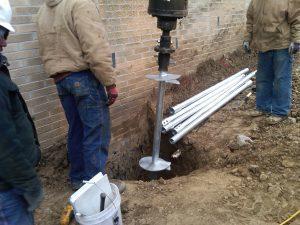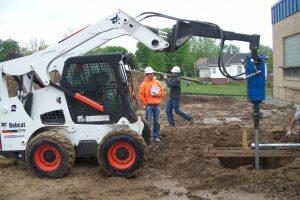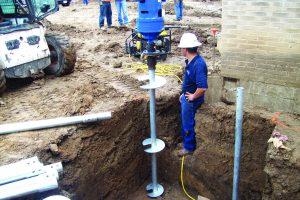Lady of Lourdes School Addition and Renovation
Challenge
The original school building for Our Lady of Lourdes Central Catholic School was constructed in 1951. Plans for a new addition and renovation of the existing building included a new gymnasium, auditorium, classrooms and administrative offices. A review of pre-construction site conditions identified cracking in the exterior brick veneer, indicating that the existing structure was experiencing differential settlement. A geotechnical exploration for the proposed addition encountered fill soils to depths of ten feet, Peoria loess and Loveland loess to depths of 32 to 45 feet, and glacial till to the explored depth of 50 feet.
Solution
Foundation recommendations included underpinning and widening sections of the existing exterior wall footings before starting the new construction and renovation phases of the project. These sections of existing foundations would receive additional load from the planned construction. New foundations placed within 15 feet of the existing building would also be supported by helical piles. A helical pile test probe was advanced to a depth of 100 feet to gather deep soil strength information. Soil parameters can be back-calculated by knowing the test probe configuration and monitoring torque in one-foot intervals during installation. An allowable pile capacity of 25 kips with a factor of safety of at least 2.0 was estimated based on the test probe information. Thirty-five retrofit helical piles and 55 new construction helical piles were proposed to support the existing structure and new addition, respectively.
For both applications, the helical pile design consisted of the Model 288 (2.875-inch OD by 0.276-inch wall) round shaft with 10”-12”-14” triple-helix lead sections and 14”- 4” double-helix extensions. Prior to the retrofit pile installation, 16-inch diameter by eight-foot deep holes were augered next to the exterior wall to allow for the multi-helix plate configuration to pass by the bottom edge of footing. Retrofit foundation brackets were then placed on the tops of the piles and positioned below and against the existing footings. The pre-augered holes were backfilled with lean concrete to the bottoms of the retrofit brackets. After the concrete had cured, the retrofit piles were uniformly loaded with hydraulic cylinders to the recommended seating load. The retrofit and new construction helical piles were advanced to depths ranging from 45 to 65 feet and to torque-correlated ultimate capacities of at least two times the design working loads of 22.5 to 25 kips (FOS ≥ 2).
We're proud to be your local experts in deep foundations, concrete lifting, leveling and sealing, and retention systems. Interested in learning more or speaking with one of our solution specialists? Email [email protected]




